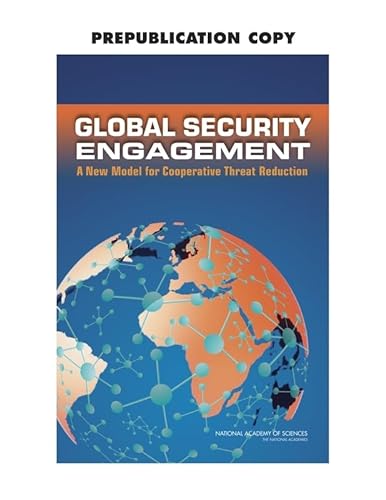Articles liés à Gobal Security Engagement: A New Model for Cooperative...

L'édition de cet ISBN n'est malheureusement plus disponible.
Afficher les exemplaires de cette édition ISBN- ÉditeurNational Academies Press
- Date d'édition2009
- ISBN 10 0309131065
- ISBN 13 9780309131063
- ReliureBroché
- Nombre de pages180
Acheter D'occasion
état : Assez bonxiv, 165, [1] pages. A Note on... En savoir plus sur cette édition
Frais de port :
EUR 4,64
Vers Etats-Unis
Meilleurs résultats de recherche sur AbeBooks
Global Security Engagement; A New Model for Cooperative Threat Reduction
Description du livre Trade paperback. Etat : Very good. Presumed First Edition, First printing. xiv, 165, [1] pages. A Note on Terminology. Footnotes. Boxes. List of Acronyms. H.R. 1585. The government's first Cooperative Threat Reduction (CTR) programs were created in 1991 to eliminate the former Soviet Union's nuclear, chemical, and other weapons and prevent their proliferation. The programs have accomplished a great deal: deactivating thousands of nuclear warheads, neutralizing chemical weapons, converting weapons facilities for peaceful use, and redirecting the work of former weapons scientists and engineers, among other efforts. The programs must be expanded to other regions and fundamentally redesigned as an active tool of foreign policy that can address contemporary threats from groups that are that are agile, networked, and adaptable. Global Security Engagement proposes how this goal can best be achieved. To meet the magnitude of new security challenges, particularly at the nexus of weapons of mass destruction and terrorism, Global Security Engagement recommends a new, more flexible, and responsive model that will draw on a broader range of partners than current programs have. As the fall of the Soviet Union appeared eminent, the United States and their allies began to worry about the concept that the nuclear weapons held in smaller countries by the Soviet Union could fall or would fall into enemy hands. The Cooperative Threat Reduction (CTR) Program was an initiative housed within the Defense Threat Reduction Agency. The CTR program is better known as the Nunn-Lugar Act based on the Soviet Nuclear Threat Reduction Act of 1991 which was authored and cosponsored by Sens. Sam Nunn and Richard Lugar. According to the CTR website, "the purpose of the CTR Program is to secure and dismantle weapons of mass destruction and their associated infrastructure in former Soviet Union states." Another explanation of purpose of the program is "to secure and dismantle weapons of mass destruction in states of the former Soviet Union and beyond". CTR provides funding and expertise for states in the former Soviet Union (including Russia, Ukraine, Georgia, Azerbaijan, Belarus, Uzbekistan, and Kazakhstan) to decommission nuclear, biological, and chemical weapon stockpiles, as agreed by the Soviet Union under disarmament treaties such as SALT I. N° de réf. du vendeur 74641

